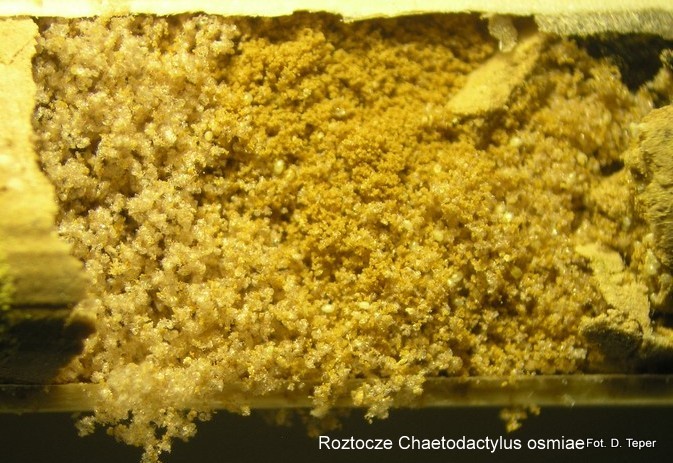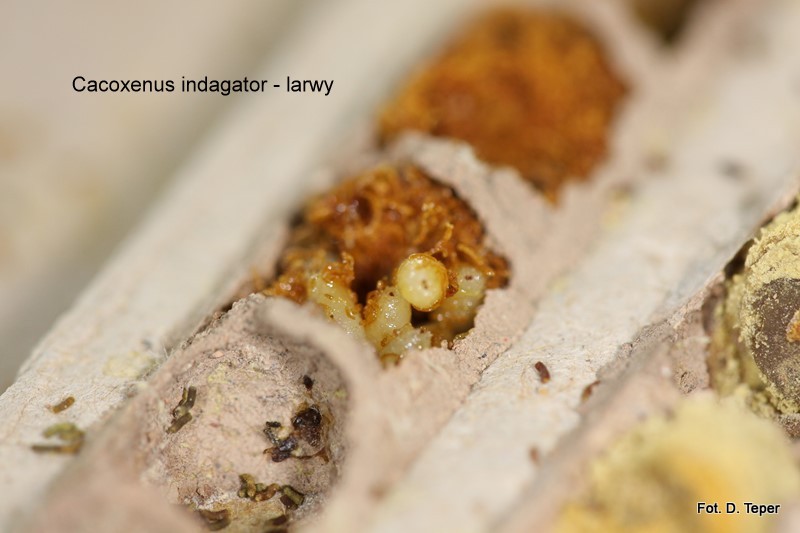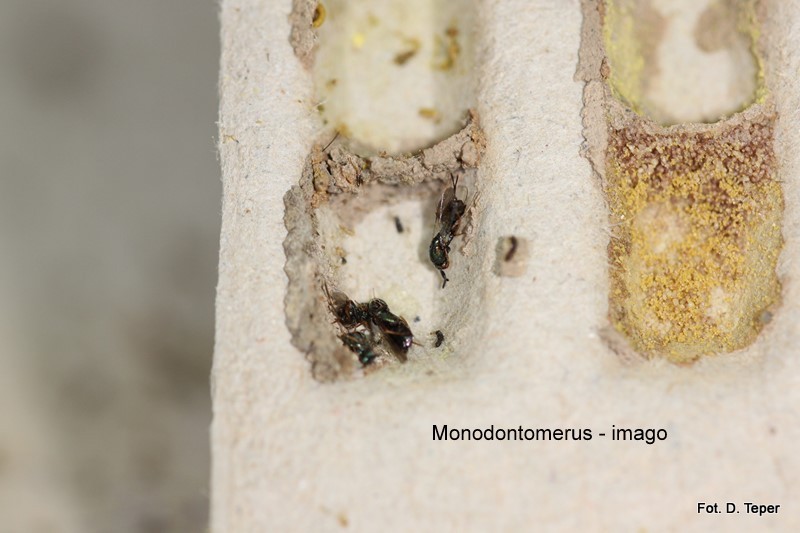

Winter Storing of Red Mason Bee Cocoons
Life cycle of the red mason bee starts in spring when the day temperature is about 15°C. Under natural conditions this can take place already at the beginning of April. Males are the first to hatch. Females hatch 7-10 days later. After mating, females start building nests. At first they build a clay or mud plug. Then they gather pollen (about 200 mg in each cell) on which they lay an egg and build a wall separating another cell. From the egg, a larva hatches and starts feeding on the gathered pollen. After eating all of the pollen the larva spins a cocoon and pupates within. At the end of summer cocoons contain adult bees that will wait inside for spring of the next year. The tubes inhabited from April to the end of May should be left in place until autumn. Shock accompanying moving or trucking the nesting boxes during larvae feeding can cause their falling off of the food and dying. It is the best to move the inhabited nests no earlier than in the middle of September.
In order to obtain maximal population increase in next years it is necessary to split open the tubes, take out the cocoons and select only well-established cocoons for overwintering. Such cocoons cannot have any signs of parasites such as circular holes. When taking the cocoons out of the tubes look especially carefully for cocoons that are almost entirely filled with light brown clusters of small mites (Chaetodactylus osmiae) that proliferated on the pollen. If reed tubes contain cells with parasites, cocoons need to be taken out very carefully to prevent contamination of cocoon's surface with mites.
Other dangerous parasites of red mason bee nests are dipterans - Cacoxenus and parasitic wasps - Monodontomerus. These parasites are also eliminated during nest inspections and by burning cocoon remnants after spring hatching of red mason bees.





Winter storage of red mason bee cocoons is not difficult. Fulfilling only several requirements will result in their overwintering in good condition and hatching in a satisfactory percentage of over 90.
A place for storing the nests needs to be planned already at the point of collecting the inhabited nests from field. Storage room needs to be cool. Storing the nests in heated rooms until taking out the cocoons, for instance, in December or January, can kill the bees inside the cocoons. Humidity of heated rooms is usually low causing reed tubes drying out. Moreover, every adult insect overwintering in a cocoon has winter supplies in their abdomen, that is fat body. Too high temperature during overwintering increases metabolism rates so the entire supply of the fat body can run out before spring and the bee can die.
So far it was thought that the best place for storing red mason bee cocoons is a refrigerator with the temperature of about 4°C. Storing the cocoons in a refrigerator has, however, a serious disadvantage. Refrigerators are usually placed in heated rooms and in the case of a low number of red mason bee cocoons are also used for other purposes, for example, storing food. Such refrigerators are frequently opened and closed. After opening the temperature inside the refrigerator increases to 10 to 20 degrees. After closing the door, the cooling unit lowers the temperature to 3-4°C in several hours. Then the doors are opened again and the temperature increases once again. And so on. Such temperature fluctuation is a signal for the red mason bee (especially for the males) that the spring is near, because in spring the temperature ranges from 10 to 20°C during the day and drops even below zero at night. We have often observed males hatching prematurely, even in January, when we stored cocoons in refrigerators.
Recent observations made during overwintering of large bunches of cocoons prove that temperature up to 10°C during overwintering does not deteriorate the survival rate of bees and does not cause their premature hatching. Temperature drops below zero do not have negative influence on the survival rate, after all, natural colonies of the red mason bee tolerate temperature drops even below -20°C. Due to the above, cocoons taken out from nests and placed in cardboard boxes can be stored, for example, in unheated buildings isolated with polystyrene foam. Polystyrene foam secures the room with cocoons from drastic temperature drops in winter and sudden increase of temperature in spring. Cool earth cellars and fruit storages are also good overwintering sites. Excluding, off course, the controlled atmosphere storages. There are reports on cocoons moulding in fruit storages due to high humidity. It is true, mould can grow on cocoons but this usually affects cocoon batches containing high amounts of residual pollen from nest cells on their surface. The mould does not cause significant losses in bees because cocoons protect the insect inside very well. However, to solve the problem of moulding cocoons I suggest overwintering them in unheated rooms and moving them to the storage in early spring when ambient temperature can exceed 10°C. In every case you need take special care to secure cocoons from rodents. Additionally, the layer of cocoons in a box should not exceed a few centimetres. Thick layer of cocoons can increase the temperature inside the box causing premature hatching of insects. The layer of cocoons prepared for sending also cannot be too thick.
Cocoons overwintered in the above-described way are to be placed on cultivation sites with sufficient amount of nesting material (700 reed tubes per 1000 cocoons) in the first half of April, however, no later than 2 weeks before the anticipated blooming of crop plants.
Dariusz Teper